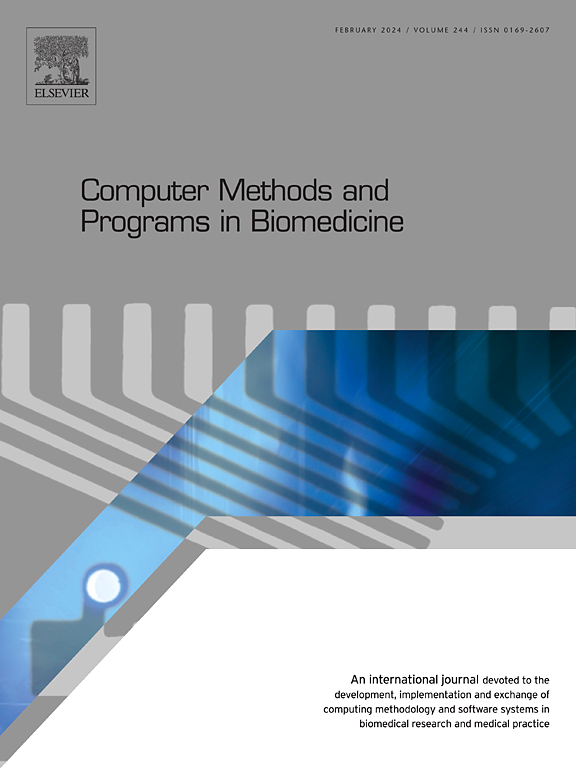动态细胞质量运动分析工具
IF 4.9
2区 医学
Q1 COMPUTER SCIENCE, INTERDISCIPLINARY APPLICATIONS
引用次数: 0
摘要
背景与目的数字全息显微镜技术为研究活细胞体外活性提供了一种新的定量图像数据。除了非侵入性和无染色成像外,它还提供细胞团块的拓扑加权。这使我们开发了一种特殊的工具来评估细胞质量动力学。方法:采用Python编程语言,利用40倍/0.95干物镜每隔30秒拍摄的人纤维肉瘤HT-1080细胞贴壁延时图像训练集,建立分析图像差分(AID)方法。结果:AID通过评估从延时序列中选择的两幅定量相位图像之间的差异,充分利用了这些新数据。用q相显微镜拍摄的hiQPI(全息非相干光源定量相位成像)图像数据证明了该方法的贡献。分析结果是图形化的,并辅以数值数据。为了强调分析图像差分(AID)方法的重要性,进行了一个初步的试点实验,以展示对捕获癌细胞运动的顺序重叠图像的可用分析。值得注意的是,除了定义单元使用区域的变化(新占用或稳定占用或更好地废弃)之外,它还引入了零线概念,表示不断移动的环境中的宁静点。结论:测量零线长度已成为表征细胞质量转移的一种新的生物标志物。证明了相变测量的灵敏度。比较了非相干(hiQPI)和相干(QPI)方法得到的输入图像的噪声质量。最后还显示了对AID方法输出的影响。本研究的发现介绍了一种新的方法来评估体外细胞行为。这个概念是一个特别值得注意的结果。总的来说,这些结果突出了艾滋病在推进癌细胞生物学领域的巨大潜力,特别是。本文章由计算机程序翻译,如有差异,请以英文原文为准。
Dynamic cell-mass movement analyses tool
Background and Objective
Digital Holographic Microscopy provides a new kind of quantitative image data about live cells’ in vitro activities. Apart from non-invasive and staining-free imaging, it offers topological weighting of cell mass. This led us to develop a particular tool for assessing cell mass dynamics.
Methods:
Programming language Python and a training set of time-lapse images of adherent HT-1080 cells derived from human fibrosarcoma taken with dry objective 40x/0.95 at 30-second intervals were used to create the Analytical Image Differencing (AID) method.
Results:
The AID makes the best of these new data by evaluating the difference between the chosen two quantitative phase images from the time-lapse series. The contribution of the method is demonstrated on hiQPI (Holographic Incoherent-light-source Quantitative Phase Imaging) image data taken with a Q-phase microscope. The analysis outputs are graphical and complemented with numerical data.
To underscore the significance of the Analytical Image Differencing (AID) method, an initial pilot experiment was conducted to show the available analyses of sequential overlapping images capturing the movement of cancer cells. Notably, besides defining changes in areas used by the cell (newly or steadily occupied or better abandoned) it is an introduction to the zero-line concept, which denotes spots of tranquility among continuously moving surroundings.
Conclusions:
The measurement of zero-line length has emerged as a novel biomarker for characterizing cell mass transfer. The sensitivity of phase change measurements is demonstrated. The noise quality of input images obtained with incoherent (hiQPI) and coherent (QPI) methods is compared. The resulting effect on the AID method output is also shown.
The findings of this study introduce a novel approach to evaluating cellular behavior in vitro. The concept emerged as a particularly noteworthy outcome. Collectively, these results highlight the substantial potential of AID in advancing the field of cancer cells biology, particularly.
求助全文
通过发布文献求助,成功后即可免费获取论文全文。
去求助
来源期刊

Computer methods and programs in biomedicine
工程技术-工程:生物医学
CiteScore
12.30
自引率
6.60%
发文量
601
审稿时长
135 days
期刊介绍:
To encourage the development of formal computing methods, and their application in biomedical research and medical practice, by illustration of fundamental principles in biomedical informatics research; to stimulate basic research into application software design; to report the state of research of biomedical information processing projects; to report new computer methodologies applied in biomedical areas; the eventual distribution of demonstrable software to avoid duplication of effort; to provide a forum for discussion and improvement of existing software; to optimize contact between national organizations and regional user groups by promoting an international exchange of information on formal methods, standards and software in biomedicine.
Computer Methods and Programs in Biomedicine covers computing methodology and software systems derived from computing science for implementation in all aspects of biomedical research and medical practice. It is designed to serve: biochemists; biologists; geneticists; immunologists; neuroscientists; pharmacologists; toxicologists; clinicians; epidemiologists; psychiatrists; psychologists; cardiologists; chemists; (radio)physicists; computer scientists; programmers and systems analysts; biomedical, clinical, electrical and other engineers; teachers of medical informatics and users of educational software.
 求助内容:
求助内容: 应助结果提醒方式:
应助结果提醒方式:


